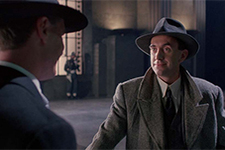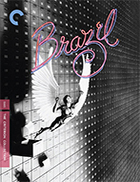Brazil (4K UHD)
|  Terry Gilliam has now directed or co-directed thirteen feature films and will likely make a few more before he shuffles off this mortal coil. However, he had never made and likely will never make a more Terry Gilliam-esque film than his conflicted masterpiece Brazil. Assembled from bits and piece of fantasy, science fiction, political fable, slapstick comedy, and social farce, it represents the full flowering of Gilliam’s unique artistic personality, which up until that point had been coming more and more into focus as he separated himself from his history with Monty Python. His previous three features—Monty Python and the Holy Grail (1975), Jabberwocky (1977), and Time Bandits (1981)—chart a path from Python-esque to Gilliam-esque, although the contours of that path constantly reinforce their mutual influences. Taking place “somewhere in the 20th century,” as an opening title card informs us, Brazil draws us into a jumbled, slightly futuristic, slightly retro world of farcical bureaucracy and political despotism. The film is a marvel of convoluted production design and absurdist art direction; the world in which it takes place is fundamentally nonsensical while also being frightening prescient. Gilliam’s obsession with physicality and tactility is fantastically embodied in the film’s various technologies, which look as though Eisenhower-era typewriters and Reagan-era computer screens somehow mated and created a hideous offspring of buttons, springs, wires, and plexiglass magnifiers. As with his previous film, Time Bandits (1981), Gilliam plays up both the allure and the ridiculousness of our technological innovations, propping them up as manufactured necessities that often do more to weigh us down. The film’s nominal hero is one Sam Lowry (Jonathan Pryce), a milquetoast button pusher in one of the government’s sprawling offices who dreams of being an armored hero, soaring majestically in the clouds on feathered wings and rescuing a beautiful damsel (Kim Greist) from aesthetically heightened horrors. The brightness and openness of Sam’s fantasies contrast sharply with his dull lived experience, which is visually defined by dim, cramped environments bustling with people and chatter that only serve to underline his isolation. He works in the Department of Records for a stressed and despised overlord named Mr. Kurtzman (Ian Holm), who is the Peter Principle personified. Sam maintains his low-level job despite the constant machinations of his wealthy and socially connected mother (Katherine Helmond), who is obsessed with status and plastic surgery and therefore cannot stand to see her son in a position that lacks power and prestige. The film’s visuals are all Gilliam madness, but we sense in the clever dialogue and sharp exchanges the presence of his co-screenwriters, the gifted and versatile playwright Tom Stoppard and actor-writer Charles McKeown, who also plays the deeply stressed and inefficient office drone who fights with Sam over the desk they inexplicably share through a wall. Sam’s button-down world is turned upside down when he gets drawn into a situation involving a rogue repairman named Harry Tuttle (Robert De Niro), who is part Robin Hood, part terrorist, at least according to Central Services, which claims all repair-work as their own, however incompetently they do it. Because of human error, an innocent man named Harry Buttle is snatched from his family by government operatives in black armor, a scene that offers an unnerving reflection of the current situation in the U.S. in which masked immigration agents are raiding houses and job sites, whisking suspected undocumented immigrants away in unmarked vans to secret detention centers (the new is always old in the authoritarian mindset). In this way, Brazil couldn’t be any more timely or explicit in its invocation of how frightening government power can be when it is wielded indiscriminately and cruelly; however funny the film often is, it is just as often disturbing and unsettling. One of Buttle’s neighbors, a hard-edged truck driver named Jill Layton (Kim Greist), tries to navigate the absurd intricacies of the bureaucratic system to find him, which is how Sam first sees her and is immediately smitten because, wouldn’t you know it, she is a dead ringer for his fantasy damsel (albeit with much shorter hair). Jill is no damsel in distress, though, and Sam’s initial attempts to help her are the awkward acts of an incompetent would-be hero rejected by the one he seeks to save, although they eventually form a team and Sam learns the pleasures of fighting against everything he has spent his life helping to support. Call it a political awakening. But, because this is a Terry Gilliam film, there are no guarantees of success or happy endings, which is one of the main reasons that Brazil ran into major distribution issues with its U.S. distributor, Universal Pictures. Even though the film had been successfully distributed in Europe in a 142-minute version, Universal executives felt that it was too long and too dour to succeed with American audiences and sought to pressure Gilliam into refashioning it into something it was never meant to be. Gilliam (being Gilliam) resisted in every way, and the eventual version that made its way into U.S. theaters was neither Gilliam’s European version or the infamous “Love Conquers All Version” that was cut behind Gilliam’s back, but rather a bastardized in-between. Thankfully, the 142-minute version eventually made its way to home video via Criterion laserdisc in the late mid-1990s, thus ensuring that Gilliam’s complete vision—demented and dark as it is—could finally be seen and appreciated.
Copyright © 2025 James Kendrick Thoughts? E-mail James Kendrick All images copyright © The Criterion Collection | |||||||||||||||||||||||||||||
Overall Rating: 


 (4)
(4)


